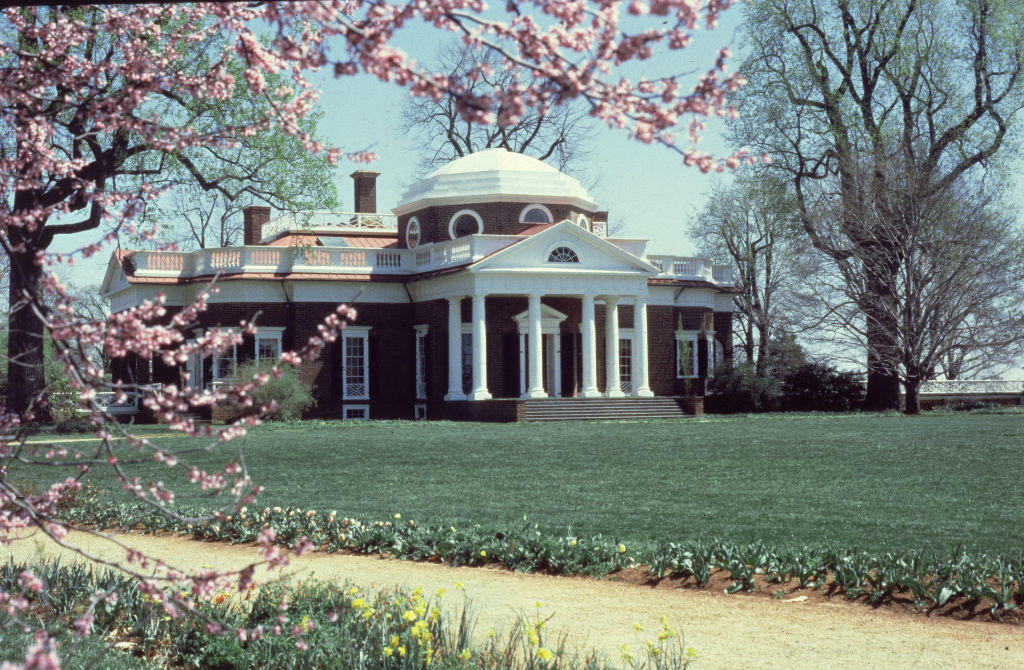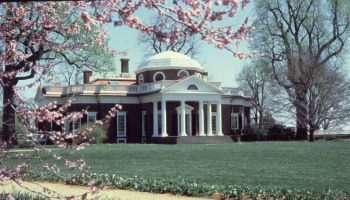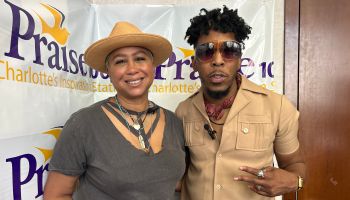
Exterior view of Monticello, the home of American president Thomas Jefferson, Charlottesville, Virginia. | Source: Kean Collection / Getty
The more conservatives whine about the non-whitewashed version of America’s history being taught, the more one thing becomes clearer: A lot of white people simply don’t think slavery was that big of a deal.
Think about it: For about a quarter of a millennium in this country, human beings were the property of other human beings who worked them day and night without compensation, bought and sold them away from their family members, physically hurt them for being disobedient, hunted them down and sometimes lynched them for trying to escape and made it so their children and their children’s children were born into that same hell.
Not only that, but many of the founders of this country engaged in and profited from slavery and lived their lives with the institution serving as their benefactor. And white America’s response to all of this is seemingly—”Eh, but what about all the other stuff they did (for white people)?
MORE: The Critical Race Theory Explainer Every White Person Should Read
So, white people are big mad that the tour of Thomas Jefferson’s famous Monticello mansion is focusing on the third president’s history as a slaver.
Let’s start with the Three Stooges of white tears over at Fox & Friends, who described the tear as “going woke” and blindsiding visitors with “a harangue on the horrors of slavery,” citing a New York Post article likely written by some other fragile white person upset that other fragile white people had to endure history that made them uncomfortable.
“It’s overwhelmingly negative!” Fox host Pete Hegseth cried. “You go to visit the legacy of Thomas Jefferson and you learn about what a terrible person Thomas Jefferson was.”
Hegseth said one visitor noted that “half of the comments on Jefferson were critical.”
First of all, if only “half the comments” about a lifelong slave owner and racist who believed Black people were intellectually inferior were “critical,” that means the other half of the comments were non-critical, right? Is literal balance not enough balance for white tourists? Are white people so entitled that they think the “critical” parts of their heroes’ stories should be footnotes rather than central parts of said stories?
Why, yes—yes that’s exactly what it seems they think.
“I visited many of these homes and that is definitely what I picked up from all of this, that there is a reorienting, reconstructing of the history to basically make sure that the idea that they had slaves is on the same level as what they did for our country,” co-host Rachel Campos-Duffy said without bothering to explain why American founders and presidents owning slaves shouldn’t be emphasized “on the same level as what they did for our country.”
She continued: “There are slaves across human history. I get that. It’s a terrible history we should talk about but we should not feel guilty or ashamed of our leaders when we go and visit the people who brought us the Constitution, the Declaration of Independence. You leave feeling that way.”
And these statements only represent the cracks in the levy that preceded a flood of white tears.
“These were great men as far as their ideas go but they were able to build this on the backs of slaves and we honor that,” said co-host Joey Jones. “And we talk about that. That’s different than re-writing the importance of Jefferson, the importance of Washington or whoever it may be. And why have Monticello at all if you’re only going to use it for grievance?”
Campos-Duffy responded: “Socialists. You come away thinking how terrible this country is. Where’s all this coming from? The homes of these presidents are being populated—this is a very diabolical plan on the part of the left. So what they’ve done is they’ve taken their donors on the left and they’ve populated the boards of these estates with leftists.”
Ah, yes—the “left” and their “diabolical plan” to teach history to people who don’t want to learn it.
“Don’t look over here at all the amazing things that Thomas Jefferson unleashed,” Hegseth said in agreement. “It’s always about inclusivity. It’s the buzzword they use. And we fall into the trap! Because good, earnest historians who take care of Monticello sit there and they go, ‘Oh, you’re right. You know what? We haven’t included enough about the fact that he was a slave owner. So let’s include more of that.’ And then the ideologues come in with their money and say, let’s make it all about that!”
Imagine accusing anyone of using buzzwords after repeatedly invoking the words “woke” and “socialist” in a context that has nothing to do with socialism. And by lamenting “inclusivity,” Hegseth is admitting he prefers a historical curriculum centered around placating white people. After all, why would Black people prefer a focus on the Constitution and Declaration of Independence that only white Americans benefitted from?
And, as far as Jefferson’s accomplishments, here’s what Smithsonian Magazine had to say:
Few of us entirely escape our times and places. Thomas Jefferson did not achieve greatness in his personal life. He had a slave as mistress. He lied about it. He once tried to bribe a hostile reporter. His war record was not good. He spent much of his life in intellectual pursuits in which he excelled and not enough in leading his fellow Americans toward great goals by example. Jefferson surely knew slavery was wrong, but he didn’t have the courage to lead the way to emancipation. If you hate slavery and the terrible things it did to human beings, it is difficult to regard Jefferson as great. He was a spendthrift, always deeply in debt. He never freed his slaves. Thus the sting in Dr. Samuel Johnson’s mortifying question, “How is it that we hear the loudest yelps for liberty from the drivers of Negroes?”
For generations, the vast majority of Americans only learned the version of Jefferson that scarcely included his legacy as a slave owner, if it was included at all. I was an adult when I learned that Jefferson owned more than 600 people in his lifetime, including 400 who were enslaved at Monticello.
So, I don’t know, maybe it’s OK that this tourist attraction teaches the truth.
SEE ALSO:
Oklahoma Gov. Investigates ‘Troubling’ Claim Tulsa Public Schools Violated State’s Anti-CRT Law
Colonizer Curriculum: Texas Educators Want To Characterize Slavery As ‘Involuntary Relocation’
Conservatives Are Big Mad They Have To Learn About Slavery At Thomas Jefferson’s Monticello Mansion was originally published on newsone.com
















